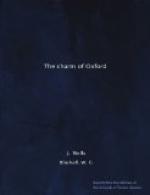The College has an interesting portrait of the great Henry, which may be authentic; but that of the Black Prince, which adorns the college hall, is known to have been painted from a handsome Oxford butcher’s boy, in the eighteenth century. While we condemn the lack of historic sense in the Provost and Fellows of that day, we may at least acquit them of any intention of pacificist irony in their choice of a model.
Queen’s has had better poets than Tickell on its rolls, but, by a curious chance, the two most eminent—Joseph Addison and William Collins—were both tempted away from their first college by the superior wealth and attractions of Magdalen.
The old local connections which were such a marked feature in the statutes of founders, and which so profoundly influenced Oxford down to the Commission of 1854, have been almost swept away at other colleges; but at Queen’s they have always been strongly maintained. It has been, and is, emphatically, a north-country college. Not the least important factor in maintaining this tradition has been the great benefaction of Lady Elizabeth Hastings, fondly and familiarly known to all Queen’s men as “Lady Betty.” Steele wrote of her when young, that to “love her was a liberal education”; this may have been flattery, but her bounty, at any rate, has given a “liberal education” to hundreds of north-country men, who come up from the twelve schools of her foundation to her college at Oxford.
It is interesting to note in Modern Oxford, attempts to re-establish those local connections, which the wisdom of our ancestors established, and which the self-complacency of Victorian reformers “vilely cast away.”
NEW COLLEGE (1) FOUNDER AND BUILDINGS
“There the kindly fates allowed
Me too room, and made me proud,
Prouder name I have not wist,
With the name of Wykehamist.”
L. JOHNSON.
[Plate X. New College : The Entrance Gateway]
Among the “Founders” of Oxford colleges, three stand out pre-eminent —all three bishops of Winchester and great public servants. If Wolsey has undisputed claims for first place, there can be little doubt that, in spite of the great public services of Bishop Foxe, the Founder of Corpus, the second place must be assigned to William of Wykeham, “sometime Lord High Chancellor of England, the sole and munificent founder of the two St. Mary Winton colleges.” Others, beside Wykehamists, hear with pleasure the magnificent roll of the titles of the Founder of New College, when one of his intellectual sons occupies the University pulpit, and gives thanks for “founders and benefactors, such as were William of Wykeham.”
In Oxford, without doubt, his great claim to be remembered will be held to be his college with the school at Winchester, which he linked to it. But he was also a reformer and a champion of Parliamentary privilege in the days when the “Good Parliament” set to work to check the misgovernment of Edward III in his dotage, and, as an architect, he is equally famous as having given to Windsor Castle its present shape, and as having secured the final triumph of the Perpendicular style by his glorious nave at Winchester.




